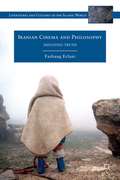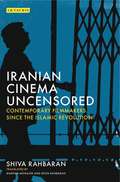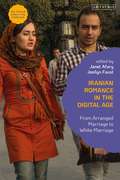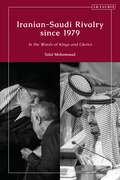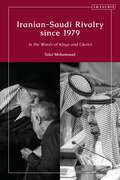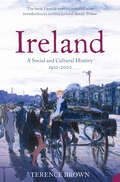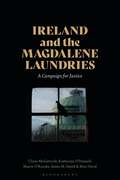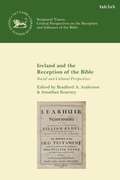- Table View
- List View
Iran between Islamic Nationalism and Secularism: The Constitutional Revolution of 1906 (British Institute of Persian Studies)
by Vanessa MartinWith the ratification of a new constitution in December 1906, Iran embarked on a great movement of systemic and institutional change which, along with the introduction of new ideas, was to be one of the most abiding legacies of the first Iranian revolution – known as the Constitutional Revolution. This uprising was significant not only for introducing secular understandings of government, but also Islamic visions of what could constitute a national assembly. The events of the Constitutional Revolution in Tehran have been much discussed, but the provinces, despite their crucial role in the revolution, have received less attention. Here, Vanessa Martin seeks to redress this imbalance. She does so firstly by analysing the role of the Islamic debate in the late nineteenth and early twentieth centuries, and its relationship with secular ideas, and secondly by examining the ramifications of this debate in the main cities of Tabriz, Shiraz, Isfahan and Bushehr. By exploring the interaction between Islam and secularism during this tumultuous time, Iran between Islamic Nationalism and Secularism concludes that in each province, the Constitutional Revolution took on a character of its own.
Iran, Revolution, and Proxy Wars (Middle East Today)
by Ofira Seliktar Farhad RezaeiThis book analyzes the historical quest of the Islamic Republic of Iran to export its revolution to the Muslim countries in the Middle East and beyond. The authors argue that Iran exported its revolution by using proxies such as Hezbollah, the Iraqi Shite militias, and the Houthis. The study unravels the casual chain behind less-known cases of Iranian sponsorship of al Qaeda (Central) and al Qaida in Iraq. It combines rigorous theory with detailed empirical analysis which can add to the current debate about ways to roll back Iran’s revolutionary export.
The Iranian Christian Diaspora: Religion and Nationhood in Exile
by Benedikt RömerOver the past few decades, whilst evading severe governmental restrictions in Iran, the Iranian Evangelical diaspora has grown across Turkey, Germany, the Netherlands, the US and the UK. Far from the censorship of the Islamic Republic, Iranian Evangelical pastors and ministers publish Persian-language Christian magazines and online videos with the aim to reach the transnational Iranian Christian community, as well as potential converts in Iran. This book explores notions of nationhood and diasporic dwelling in the religious narratives and practices of Iranian Christian exilic communities, showing how claims to the authenticity of a distinct Iranian-Christian identity are constructed. Examining abundant source material available in the Iranian Christian exilic milieu, the book draws extensively upon five unstudied series of Persian-language Christian exile magazines published between the early 1990s and the 2020s, Persian-language video material and a number of interviews with Iranian Christian pastors with leadership positions in the Iranian Christian diaspora. These sources demonstrate the significance of exile and religious affiliation as key factors shaping diasporic images of the homeland and visions of a future return. Benedikt Römer weaves the history and contemporary story of the Iranian Christian community together, placing it in the context of a wider ongoing religious transformation in Iranian society.
The Iranian Christian Diaspora: Religion and Nationhood in Exile
by Benedikt RömerOver the past few decades, whilst evading severe governmental restrictions in Iran, the Iranian Evangelical diaspora has grown across Turkey, Germany, the Netherlands, the US and the UK. Far from the censorship of the Islamic Republic, Iranian Evangelical pastors and ministers publish Persian-language Christian magazines and online videos with the aim to reach the transnational Iranian Christian community, as well as potential converts in Iran. This book explores notions of nationhood and diasporic dwelling in the religious narratives and practices of Iranian Christian exilic communities, showing how claims to the authenticity of a distinct Iranian-Christian identity are constructed. Examining abundant source material available in the Iranian Christian exilic milieu, the book draws extensively upon five unstudied series of Persian-language Christian exile magazines published between the early 1990s and the 2020s, Persian-language video material and a number of interviews with Iranian Christian pastors with leadership positions in the Iranian Christian diaspora. These sources demonstrate the significance of exile and religious affiliation as key factors shaping diasporic images of the homeland and visions of a future return. Benedikt Römer weaves the history and contemporary story of the Iranian Christian community together, placing it in the context of a wider ongoing religious transformation in Iranian society.
Iranian Cinema and Philosophy: Shooting Truth (Literatures and Cultures of the Islamic World)
by Farhang ErfaniIn film studies, Iranian films are kept at a distance, as 'other,' different, and exotic. In reponse, this book takes these films as philosophically relevant and innovative. Each chapter of this book is devoted to analyzing a single film, and each chapter focuses on one philosopher and one particular aesthetic question.
Iranian Cinema Uncensored: Contemporary Film-makers since the Islamic Revolution (International Library of the Moving Image (PDF))
by Shiva RahbaranThe New Iranian Cinema is considered by many to be the most fascinating cultural phenomenon produced within the Islamic Republic of Iran. Containing twelve first-hand interviews with the most renowned film-makers living and working in contemporary Iran, this book provides insights into film-making within a society often at odds with its rulers. Reflecting upon the 1979 revolution and its influence on their work, as well as the effect of their films on Iranian audiences, film-makers such as Abbas Kiarostami and Jafar Panahi highlight the key issues surrounding the reception of Iranian cinema in the West and also its role in the development of Iran's global image. Through these conversations Shiva Rahbaran reveals that the seeds of the New Iranian Cinema were sown long before the revolution, and that Iranian film-makers gave rise to a cinema which became a global phenomenon despite censorship, sanctions and political isolation.
Iranian Identity and Cosmopolitanism: Spheres of Belonging (Suspensions: Contemporary Middle Eastern and Islamicate Thought)
by Lucian StoneSince cosmopolitanism has often been conceived as a tenet of 'Western civilization' that emanates from its Enlightenment-based origins in a humanist age of modernity, Iranian Identity and Cosmopolitanism: Spheres of Belonging advances a highly innovative gesture by contemplating the implications and relevance of the idea in a so-called non-Western cultural territory. The particularities of the Iranian and Islamic context shed new light on advancements and obstacles to cosmopolitan praxis. The volume provides four principle disciplinary assessments of cosmopolitanism: philosophy, political science, sociology, and cultural studies,including literary criticism. The authors in this collection critically examine topics including the historical encounter between Iranian and Western thinkers and its impact on Iranian political ideals; the tension between maintaining apolitical-theology rooted in metaphysical assumptions and the prerequisite of secularism in cosmopolitan and democratic philosophies. This highly innovative volume will be of interest to scholars and students of Middle Eastern and Iranian Studies, Islamic Studies, Globalization, Political Science and Philosophy.
Iranian Identity and Cosmopolitanism: Spheres of Belonging (Suspensions: Contemporary Middle Eastern and Islamicate Thought)
by Lucian StoneSince cosmopolitanism has often been conceived as a tenet of 'Western civilization' that emanates from its Enlightenment-based origins in a humanist age of modernity, Iranian Identity and Cosmopolitanism: Spheres of Belonging advances a highly innovative gesture by contemplating the implications and relevance of the idea in a so-called non-Western cultural territory. The particularities of the Iranian and Islamic context shed new light on advancements and obstacles to cosmopolitan praxis. The volume provides four principle disciplinary assessments of cosmopolitanism: philosophy, political science, sociology, and cultural studies,including literary criticism. The authors in this collection critically examine topics including the historical encounter between Iranian and Western thinkers and its impact on Iranian political ideals; the tension between maintaining apolitical-theology rooted in metaphysical assumptions and the prerequisite of secularism in cosmopolitan and democratic philosophies. This highly innovative volume will be of interest to scholars and students of Middle Eastern and Iranian Studies, Islamic Studies, Globalization, Political Science and Philosophy.
Iranian Immigration to Israel: History and Voices, in the Shadow of Kings (Routledge Studies in Middle Eastern Society)
by Ali L. EzzatyarExploring the fascinating history behind Iranian-Jewish immigration to Israel, this book offers a rare and untold history of one of Israel’s Middle Eastern Jewish populations. Over the twentieth century, thousands among Iran’s Jewish community left their ancestral homes and immigrated to the Jewish State, while thousands remained in Iran, even after the birth of the Islamic Republic of Iran. Using first-hand narratives, the evolution of Zionist activities and recruitment in Iran over the last century is covered, alongside an Iranian-Jewish population that, unlike other Middle Eastern Jewish communities, did not ultimately arrive in the Holy Land as a majority of their community. For those that did arrive (or, make aliyah) the Israeli nation-building process had unique ramifications. The integrative process and current status of the Iranian community in Israel is also examined, providing an intimate picture of Iranian life in Israel, nearly 75 years after Israel’s establishment. A natural addition to any collection on Jewish or Israeli history, and essential reading for a full understanding of Iran-Israel relations, students of Israeli nation-building and affairs, as well as Iranian history, demographics, and politics will find this book invaluable.
Iranian Immigration to Israel: History and Voices, in the Shadow of Kings (Routledge Studies in Middle Eastern Society)
by Ali L. EzzatyarExploring the fascinating history behind Iranian-Jewish immigration to Israel, this book offers a rare and untold history of one of Israel’s Middle Eastern Jewish populations. Over the twentieth century, thousands among Iran’s Jewish community left their ancestral homes and immigrated to the Jewish State, while thousands remained in Iran, even after the birth of the Islamic Republic of Iran. Using first-hand narratives, the evolution of Zionist activities and recruitment in Iran over the last century is covered, alongside an Iranian-Jewish population that, unlike other Middle Eastern Jewish communities, did not ultimately arrive in the Holy Land as a majority of their community. For those that did arrive (or, make aliyah) the Israeli nation-building process had unique ramifications. The integrative process and current status of the Iranian community in Israel is also examined, providing an intimate picture of Iranian life in Israel, nearly 75 years after Israel’s establishment. A natural addition to any collection on Jewish or Israeli history, and essential reading for a full understanding of Iran-Israel relations, students of Israeli nation-building and affairs, as well as Iranian history, demographics, and politics will find this book invaluable.
Iranian Islam: The Concept of the Individual
by Fereshteh Ahmadi Nader AhmadiThe author examines from different perspectives (theological and philosophical as well as socio-political and historical) the significance of the concept of the individual in the ways of thinking of Iranians. This book establishes that the mystical dimension of Islamic thought, the divine nature of Islamic law and, the mode of relationship between ruler and the ruled, in combination, counteracted growth of concern for the individual self in Iranian thought.
Iranian Jews in Israel: Between Persian Cultural Identity and Israeli Nationalism (Library of Modern Middle East Studies)
by Alessandra CecolinRecent, post-revolutionary Iranian cinema has of course gained the attention of international audiences who have been struck by its powerful, poetic and often explicitly political explorations. Yet mainstream, pre-revolutionary Iranian cinema, with a history stretching back to the early twentieth century, has been perceived in the main as lacking in artistic merit and, crucially, as apolitical in content. This highly readable history of Iran as revealed through the full breadth of its cinema re-reads the films themselves to tell the full story of shifting political, economic and social situations. Sadr argues that embedded within even the seemingly least noteworthy of mainstream Iranian films, we find themes and characterisations which reveal the political contexts of their time and which express the ideological underpinnings of a society. Beginning with the introduction of cinema to Iran through the Iranian monarchy the book covers the broad spectrum of Iran's cinema, offering vivid descriptions of all key films. Iranian Cinema looks at recurring themes and tropes, such as the rural versus the 'corrupt' city and, recently, the preponderance of images of childhood, and asks what these have revealed about Iranian society. The author brings the story up to date explaining Iranian filmmaking after the events of September 11, from Mohsen Makhmalbaf's astonishing Kandahar to Saddiq Barmak's angry work Osama, to explore this most recent and breathtaking revival in Iranian cinema.
The Iranian Metaphysicals: Explorations in Science, Islam, and the Uncanny
by Alireza DoostdarWhat do the occult sciences, séances with the souls of the dead, and appeals to saintly powers have to do with rationality? Since the late nineteenth century, modernizing intellectuals, religious leaders, and statesmen in Iran have attempted to curtail many such practices as "superstitious," instead encouraging the development of rational religious sensibilities and dispositions. However, far from diminishing the diverse methods through which Iranians engage with the immaterial realm, these rationalizing processes have multiplied the possibilities for metaphysical experimentation. The Iranian Metaphysicals examines these experiments and their transformations over the past century. Drawing on years of ethnographic and archival research, Alireza Doostdar shows that metaphysical experimentation lies at the center of some of the most influential intellectual and religious movements in modern Iran. These forms of exploration have not only produced a plurality of rational orientations toward metaphysical phenomena but have also fundamentally shaped what is understood as orthodox Shi‘i Islam, including the forms of Islamic rationality at the heart of projects for building and sustaining an Islamic Republic. Delving into frequently neglected aspects of Iranian spirituality, politics, and intellectual inquiry, The Iranian Metaphysicals challenges widely held assumptions about Islam, rationality, and the relationship between science and religion.
The Iranian Metaphysicals: Explorations in Science, Islam, and the Uncanny
by Alireza DoostdarWhat do the occult sciences, séances with the souls of the dead, and appeals to saintly powers have to do with rationality? Since the late nineteenth century, modernizing intellectuals, religious leaders, and statesmen in Iran have attempted to curtail many such practices as "superstitious," instead encouraging the development of rational religious sensibilities and dispositions. However, far from diminishing the diverse methods through which Iranians engage with the immaterial realm, these rationalizing processes have multiplied the possibilities for metaphysical experimentation. The Iranian Metaphysicals examines these experiments and their transformations over the past century. Drawing on years of ethnographic and archival research, Alireza Doostdar shows that metaphysical experimentation lies at the center of some of the most influential intellectual and religious movements in modern Iran. These forms of exploration have not only produced a plurality of rational orientations toward metaphysical phenomena but have also fundamentally shaped what is understood as orthodox Shi‘i Islam, including the forms of Islamic rationality at the heart of projects for building and sustaining an Islamic Republic. Delving into frequently neglected aspects of Iranian spirituality, politics, and intellectual inquiry, The Iranian Metaphysicals challenges widely held assumptions about Islam, rationality, and the relationship between science and religion.
Iranian Romance in the Digital Age: From Arranged Marriage to White Marriage (Sex, Family and Culture in the Middle East)
by Janet Afary and Jesilyn FaustFollowing the 1979 Islamic Revolution, there was a dramatic reversal of women's rights, and the state revived many premodern social conventions through modern means and institutions. Customs such as the enforced veiling of women, easy divorce for men, child marriage, and polygamy were robustly reintroduced and those who did not conform to societal strictures were severely punished. At the same time, new social and economic programs benefited the urban and rural poor, especially women, which had a direct impact on gender relations and the institution of marriage.Edited by Janet Afary and Jesilyn Faust, this interdisciplinary volume responds to the growing interest and need for literature on gender, marriage and family relations in the Islamic context. The book examines how the institution of marriage transformed in Iran, paying close attention to the country's culture and politics. Part One examines marital changes in the rural and tribal sectors of society through the works of anthropologists Erika Friedl and Mary Hegland. Part Two turns its eye to look at changes in urban marriages to new forms of cohabitation. In Part Three, the contributors explore the way technology and social media has impacted and altered the institution of family. Based on the work of new and established scholars, the collection provides an up-to-date study of an important and intensely politicized subject.
Iranian Romance in the Digital Age: From Arranged Marriage to White Marriage (Sex, Family and Culture in the Middle East)
Following the 1979 Islamic Revolution, there was a dramatic reversal of women's rights, and the state revived many premodern social conventions through modern means and institutions. Customs such as the enforced veiling of women, easy divorce for men, child marriage, and polygamy were robustly reintroduced and those who did not conform to societal strictures were severely punished. At the same time, new social and economic programs benefited the urban and rural poor, especially women, which had a direct impact on gender relations and the institution of marriage.Edited by Janet Afary and Jesilyn Faust, this interdisciplinary volume responds to the growing interest and need for literature on gender, marriage and family relations in the Islamic context. The book examines how the institution of marriage transformed in Iran, paying close attention to the country's culture and politics. Part One examines marital changes in the rural and tribal sectors of society through the works of anthropologists Erika Friedl and Mary Hegland. Part Two turns its eye to look at changes in urban marriages to new forms of cohabitation. In Part Three, the contributors explore the way technology and social media has impacted and altered the institution of family. Based on the work of new and established scholars, the collection provides an up-to-date study of an important and intensely politicized subject.
Iranian-Saudi Rivalry since 1979: In the Words of Kings and Clerics
by Talal MohammadThe fraught relationship between Saudi Arabia and Iran is usually attributed to sectarian differences, even by the states' own elites. However, this book shows that in their official speeches, newspaper editorials and Friday sermons, these elites use sectarian and nationalist references and tropes to denigrate each other and promote themselves in the eyes of their respective constituencies in the region. Talal Mohammad, who is fluent in both Arabic and Persian, examines Saudi-Iranian rivalry using discourse analysis of these religious, political and journalistic sources. Tracing what has been produced since 1979 in parallel, he argues for a consistent pattern of mutual misrepresentation, whereby each frames its counterpart as the 'Other' to which a specific political agenda can be justified and advanced. The book covers key events including the Iranian Revolution, the invasion of Kuwait in 1990, the Taliban war, the fall of Saddam, the Arab Spring, the rise of Mohammed bin Salman, and the war on ISIS. While until now Saudi-Iranian rivalry has been understood in primarily sectarian or geopolitical terms, the author argues here that the discursive othering serves as a propagandist function that supports more fundamental political and geopolitical considerations.
Iranian-Saudi Rivalry since 1979: In the Words of Kings and Clerics
by Talal MohammadThe fraught relationship between Saudi Arabia and Iran is usually attributed to sectarian differences, even by the states' own elites. However, this book shows that in their official speeches, newspaper editorials and Friday sermons, these elites use sectarian and nationalist references and tropes to denigrate each other and promote themselves in the eyes of their respective constituencies in the region. Talal Mohammad, who is fluent in both Arabic and Persian, examines Saudi-Iranian rivalry using discourse analysis of these religious, political and journalistic sources. Tracing what has been produced since 1979 in parallel, he argues for a consistent pattern of mutual misrepresentation, whereby each frames its counterpart as the 'Other' to which a specific political agenda can be justified and advanced. The book covers key events including the Iranian Revolution, the invasion of Kuwait in 1990, the Taliban war, the fall of Saddam, the Arab Spring, the rise of Mohammed bin Salman, and the war on ISIS. While until now Saudi-Iranian rivalry has been understood in primarily sectarian or geopolitical terms, the author argues here that the discursive othering serves as a propagandist function that supports more fundamental political and geopolitical considerations.
Iran’s Foreign Policy After the Nuclear Agreement: Politics of Normalizers and Traditionalists (Middle East Today)
by Farhad RezaeiThe book offers the first systematic account of Iran’s foreign policy following the nuclear agreement (JCPOA) of July 14, 2015. The author evaluates in what ways the JCPOA, in conjunction with the dramatic changes taking shape in the international order, have affected Iran’s foreign policy. Known as Normalizers, the moderate leadership under President Hassan Rouhani had planned to normalize Iran’s foreign relations by curtailing terrorism and reintegrate Iran into the community of nations. Their hardline opponents, the Principalists, rejected the JCPOA as a tool of subjection to the West and insisted on exporting the Islamist revolution, a source of much destabilization and terror in the region and beyond. The project also analyzes the struggle between Normalizers and their hardline opponents with regards to global and regional issues and Iran’s foreign policy towards global powers including the U.S., Russia, EU, and regional countries including Iraq, Syria, Israel, Saudi Arabia and Turkey.
Iraq’s Last Jews: Stories of Daily Life, Upheaval, and Escape from Modern Babylon (Palgrave Studies in Oral History)
by T. Morad D. ShashaIraq's Last Jews is a collection of first-person accounts by Jews about their lives in Iraq's once-vibrant, 2500 year-old Jewish community and about the disappearance of that community in the middle of the 20th century. This book tells the story of this last generation of Iraqi Jews, who both reminisce about their birth country and describe the persecution that drove them out, the result of Nazi influences, growing Arab nationalism, and anger over the creation of the State of Israel.
Ireland: A Social and Cultural History 1922–2001
by null Dr. Terence BrownThe seminal history of Ireland’s most unusual century, thoroughly updated for the new millennium. With its starting point the bloody creation of the Irish Free State in 1922, Ireland: A Social and Cultural History explores how Irish identity has shifted across eighty years of unprecedented change and violence. What was the legacy of De Valera and Sinn Fein – or of remaining neutral during the Second World War? What were the effects of the establishment of a formally recognised Republic of Ireland in 1949 and thus the continued status of Northern Ireland as part of Great Britain? How has the state of virtual civil war that has existed between Catholics and Protestants in Northern Ireland ever since altered the course of Irish history? Terence Brown evokes all the turbulent (and often confusing) events of the last century and makes sense of them, showing with skill and wit just how Irish culture escaped from W B Yeats' backward-looking Celtic Twilight towards modernity. Ireland: A Social and Cultural History is a fascinating work of synthesis – and an unforgettable book. Note that it has not been possible to include the same picture content that appeared in the original print version.
Ireland and the Magdalene Laundries: A Campaign for Justice
by Claire McGettrick Katherine O’Donnell Maeve O'Rourke James M. Smith Mari SteedBetween 1922 and 1996, over 10,000 girls and women were imprisoned in Magdalene Laundries, including those considered 'promiscuous', a burden to their families or the state, those who had been sexually abused or raised in the care of the Church and State, and unmarried mothers. These girls and women were subjected to forced labour as well as psychological and physical maltreatment. Using the Irish State's own report into the Magdalene institutions, as well as testimonies from survivors and independent witnesses, this book gives a detailed account of life behind the high walls of Ireland's Magdalene institutions. The book offers an overview of the social, cultural and political contexts of institutional survivor activism, the Irish State's response culminating in the The Ryan Report, and the formation of the Justice for Magdalenes campaign, a volunteer-run survivor advocacy group.Ireland and the Magdalene Laundries documents the ongoing work carried out by the Justice for Magdalenes group in advancing public knowledge and research into Magdalene Laundries, and how the Irish State continues to evade its responsibilities not just to survivors of the Magdalenes but also in providing a truthful account of what happened. Drawing from a variety of primary sources, this book reveals the fundamental flaws in the state's investigation and how the treatment of the burials, exhumation and cremation of former Magdalene women remains a deeply troubling issue today, emblematic of the system of torture and studious official neglect in which the Magdalene women lived their lives.The Authors are donating all royalties in the name of the women who were held in the Magdalenes to EPIC (Empowering People in Care).
Ireland and the Magdalene Laundries: A Campaign for Justice
by Claire McGettrick Katherine O’Donnell Maeve O'Rourke James M. Smith Mari SteedBetween 1922 and 1996, over 10,000 girls and women were imprisoned in Magdalene Laundries, including those considered 'promiscuous', a burden to their families or the state, those who had been sexually abused or raised in the care of the Church and State, and unmarried mothers. These girls and women were subjected to forced labour as well as psychological and physical maltreatment. Using the Irish State's own report into the Magdalene institutions, as well as testimonies from survivors and independent witnesses, this book gives a detailed account of life behind the high walls of Ireland's Magdalene institutions. The book offers an overview of the social, cultural and political contexts of institutional survivor activism, the Irish State's response culminating in the The Ryan Report, and the formation of the Justice for Magdalenes campaign, a volunteer-run survivor advocacy group.Ireland and the Magdalene Laundries documents the ongoing work carried out by the Justice for Magdalenes group in advancing public knowledge and research into Magdalene Laundries, and how the Irish State continues to evade its responsibilities not just to survivors of the Magdalenes but also in providing a truthful account of what happened. Drawing from a variety of primary sources, this book reveals the fundamental flaws in the state's investigation and how the treatment of the burials, exhumation and cremation of former Magdalene women remains a deeply troubling issue today, emblematic of the system of torture and studious official neglect in which the Magdalene women lived their lives.The Authors are donating all royalties in the name of the women who were held in the Magdalenes to EPIC (Empowering People in Care).
Ireland and the Popish Plot
by John GibneyThe first expansive study of how when the Popish Plot of 1678 came to light, fears of an Irish Catholic rebellion amongst Ireland's uneasy Protestant elite, who dominated over the Catholic majority population, were manipulated in England in an attempt to block the Catholic Duke of York from succeeding to the throne.
Ireland and the Reception of the Bible: Social and Cultural Perspectives (The Library of Hebrew Bible/Old Testament Studies)
by Bradford A. Anderson Jonathan KearneyDrawing on the work of leading figures in biblical, religious, historical, and cultural studies in Ireland and beyond, this volume explores the reception of the Bible in Ireland, focusing on the social and cultural dimensions of such use of the Bible. This includes the transmission of the Bible, the Bible and identity formation, engagement beyond Ireland, and cultural and artistic appropriation of the Bible. The chapters collected here are particularly useful and insightful for those researching the use and reception of the Bible, as well as those with broader interests in social and cultural dimensions of Irish history and Irish studies.The chapters challenge the perception in the minds of many that the Bible is a static book with a fixed place in the world that can be relegated to ecclesial contexts and perhaps academic study. Rather, as this book shows, the role of the Bible in the world is much more complex. Nowhere is this clearer than in Ireland, with its rich and complex religious, cultural, and social history. This volume examines these very issues, highlighting the varied ways in which the Bible has impacted Irish life and society, as well as the ways in which the cultural specificity of Ireland has impacted the use and development of the Bible both in Ireland and further afield.




